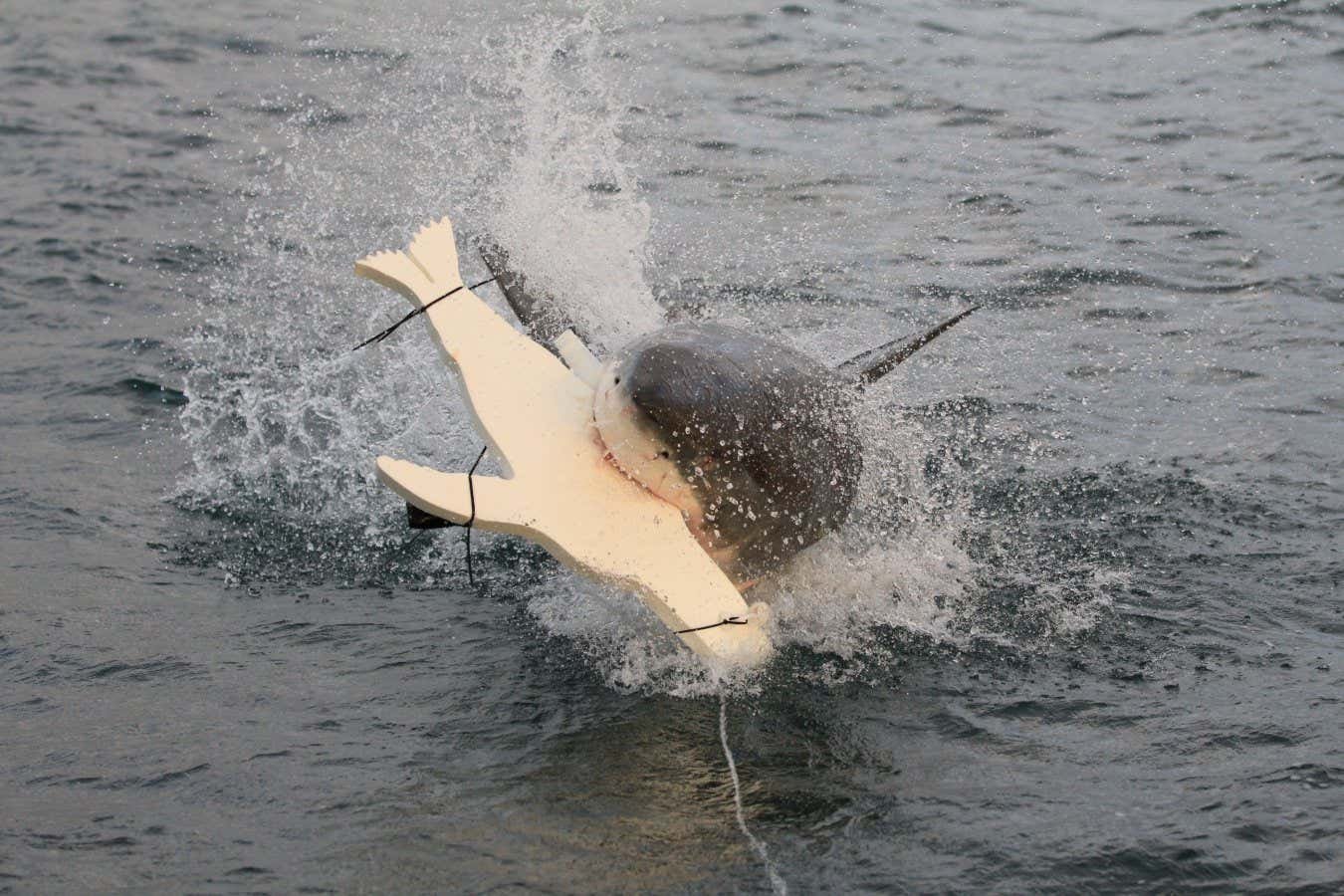
A great white shark attacks a dummy seal during an experiment where lights were used to deter shark attacks
Nathan Hart, Macquarie University
Installing lighting on the underside of surfboards, kayaks or wetsuits could prevent the majority of great white shark attacks on humans.
It has long been known that sharks often attack humans because they mistake their silhouettes at the surface for prey, such as seals. Now, researchers have conducted an experiment to see what happens if they break up the silhouette by illuminating the underside of a decoy seal to disguise its shape.
Laura Ryan at Macquarie University in Sydney and her colleagues spent nearly 500 hours towing seal-shaped decoys around Mossel Bay in the Western Cape region of South Africa, where great white sharks (Carcharodon carcharias) gather and hunt in large numbers.
The team tested multiple light treatments: covering the underside of the decoys with dim, intermediate and bright LED lighting and strobe lighting, as well as horizontal and vertical strip lighting. After each tow with one of the light treatments, they immediately towed a control decoy seal without any underside lighting. As an extra experiment, they did paired tests where the unlit control dummy was towed 3 metres away from the illuminated dummy.
The unlit decoys were attacked or followed by sharks more than any of the illuminated decoys. The brightest light seemed to be most effective, with zero predator incidents seen when the decoy’s illumination was most radiant.
Vertical strip lighting was less effective than the horizontal strips, possibly because it broke the silhouette into longer sections that could still be identified as a seal, says Ryan.
The strobe lighting was less effective than continuous lighting, perhaps because the sharks could still see the silhouette of what they thought was prey between flashes.
Ryan says the team expected it would be important for the lighting on the decoys to match the background light, to ensure it wasn’t brighter than ambient underwater conditions, but this wasn’t the case.
“The most critical thing was that the brightness on the decoy had to be brighter than or equal to the background light,” she says. “As long as the lighting stopped the silhouette from looking black, it seemed to work.”
The team has now developed a prototype lighting array to be used as a great white shark deterrent. “We are now moving from research into providing protection for swimmers and surfers,” says Ryan. “We have taken the approach of understanding these animals’ sensory system and how they see the world, and their behaviour.”
Ryan cautions that the illumination deterrent hasn’t been tested on other species known to attack people, such as tiger sharks (Galeocerdo cuvier) and bull sharks (Carcharhinus leucas), which have different hunting strategies.
David Booth at the University of Technology Sydney does a lot of field research off the Sydney coastline where sharks, including great whites, are common. Based on these findings, he says he will definitely be ordering a counter-illuminated wetsuit when they are available.
“I’d have thought that background-matching, lower illumination would be most effective, so I was surprised to see that ‘disruptive camouflage’ worked better,” he says.
“These results apply to white sharks only and for this feeding mode only, so it’s unclear how widely applicable they are at present.”
Topics:

Felecia Phillips Ollie DD (h.c.) is the inspiring leader and founder of The Equality Network LLC (TEN). With a background in coaching, travel, and a career in news, Felecia brings a unique perspective to promoting diversity and inclusion. Holding a Bachelor’s Degree in English/Communications, she is passionate about creating a more inclusive future. From graduating from Mississippi Valley State University to leading initiatives like the Washington State Department of Ecology’s Equal Employment Opportunity Program, Felecia is dedicated to making a positive impact. Join her journey on our blog as she shares insights and leads the charge for equity through The Equality Network.




